As more and more people are taking the opportunity for self-employment, and as technology allows many of us to work remotely, coworking spaces have experienced massive growth over the past few years. Companies such as WeWork and Impact Hub are making their presences known nationally, and single coworking spaces and small chains are cropping up in cities around the country.
These spaces have appeal because they’re designed to configure to how people best work today, and this approach shouldn’t be reserved for coworking concepts. At Shea, we take the most impactful elements and use them to design individual offices and office-tower common areas for our clients. And we’ve broken down what makes coworking spaces work (while eliminating the parts that don’t).
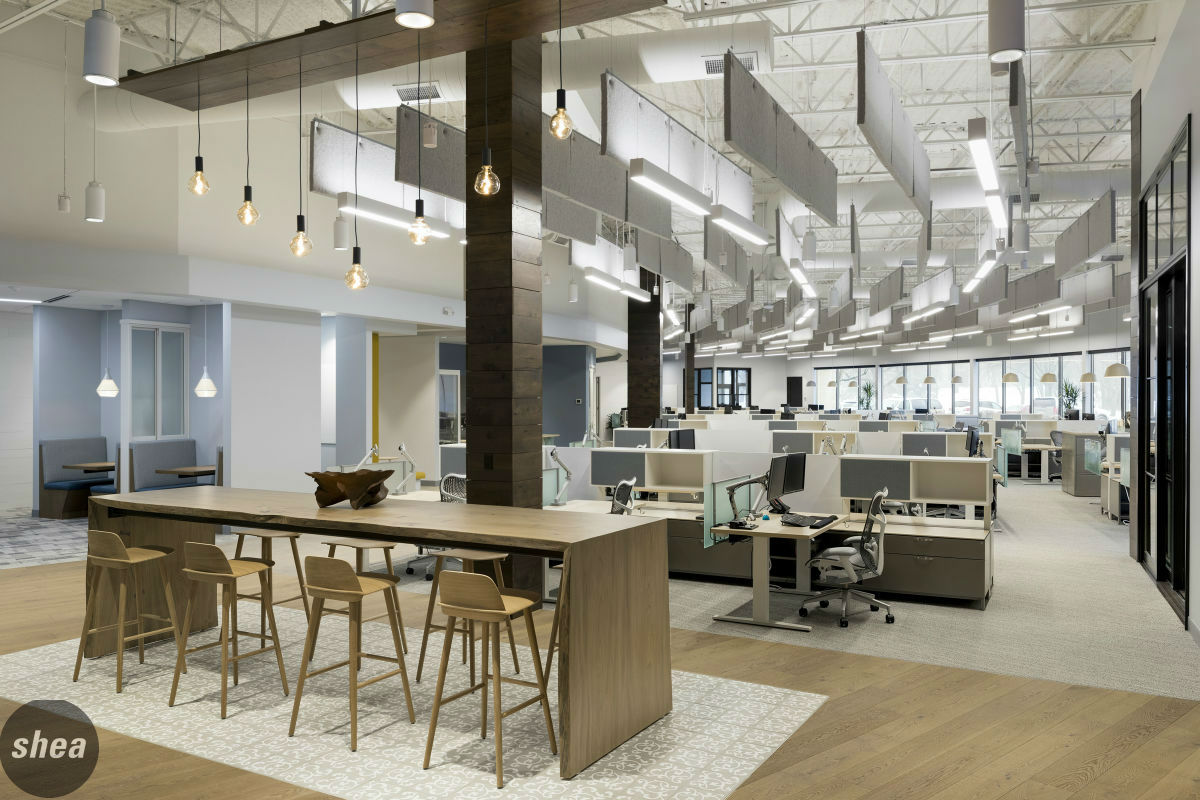
Autonomy and Flexibility
One major reason that coworking spaces are on the rise is that more people are self-employed or contract employees—so while they may not have a traditional office, they crave the structure of going somewhere to get work done, but in a less formal space than a traditional cubicle or office.

This is where flexibility becomes key. Modern offices need to be designed with several different types of workspaces, so that employees can choose which configuration works best for them that day. The key to these workspaces is to embrace not only form, but function—the biggest mistake that many designers make is in selecting chairs that look lounge-y and photograph well, but lack basic ergonomics. These seating areas look appealing, but after 30 minutes, they take a toll on arms, necks, shoulders, and backs. At Shea, we know that form is important but should never interfere with function.
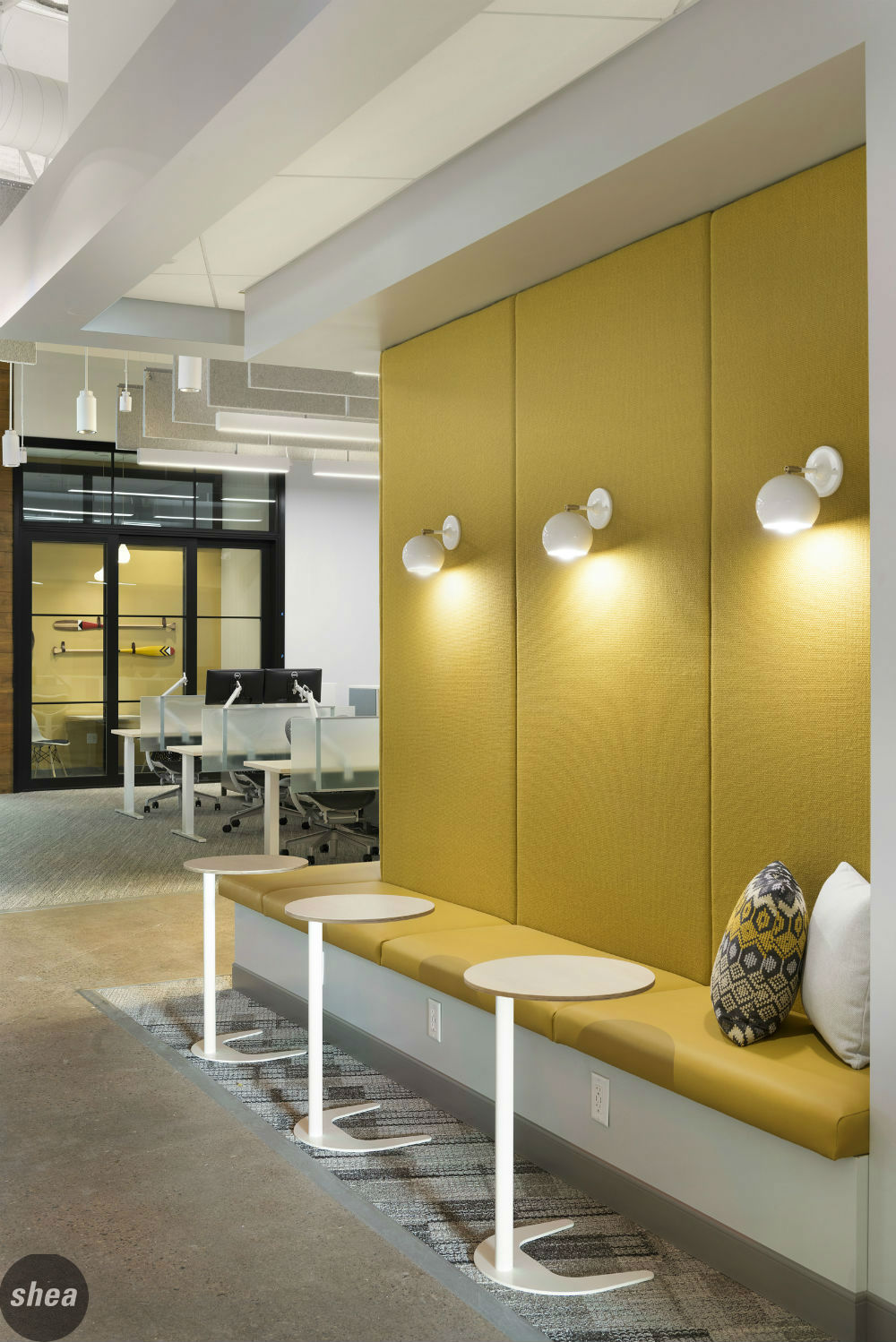 While designing the new Twin Cities office branch for Marvin Windows, our team created a “me and we” mentality for the different available spaces. We created a huge variety of spaces, including individual work rooms, traditional desks, soft-seating nooks, lounges, conference rooms, and more, so that workers have the autonomy to select the kind of space they require for the kind of work they’re doing—whether it’s “me” worktime or collaborative “we” worktime. And every one of those furnishings was chosen with ergonomics and productivity in mind.
While designing the new Twin Cities office branch for Marvin Windows, our team created a “me and we” mentality for the different available spaces. We created a huge variety of spaces, including individual work rooms, traditional desks, soft-seating nooks, lounges, conference rooms, and more, so that workers have the autonomy to select the kind of space they require for the kind of work they’re doing—whether it’s “me” worktime or collaborative “we” worktime. And every one of those furnishings was chosen with ergonomics and productivity in mind.
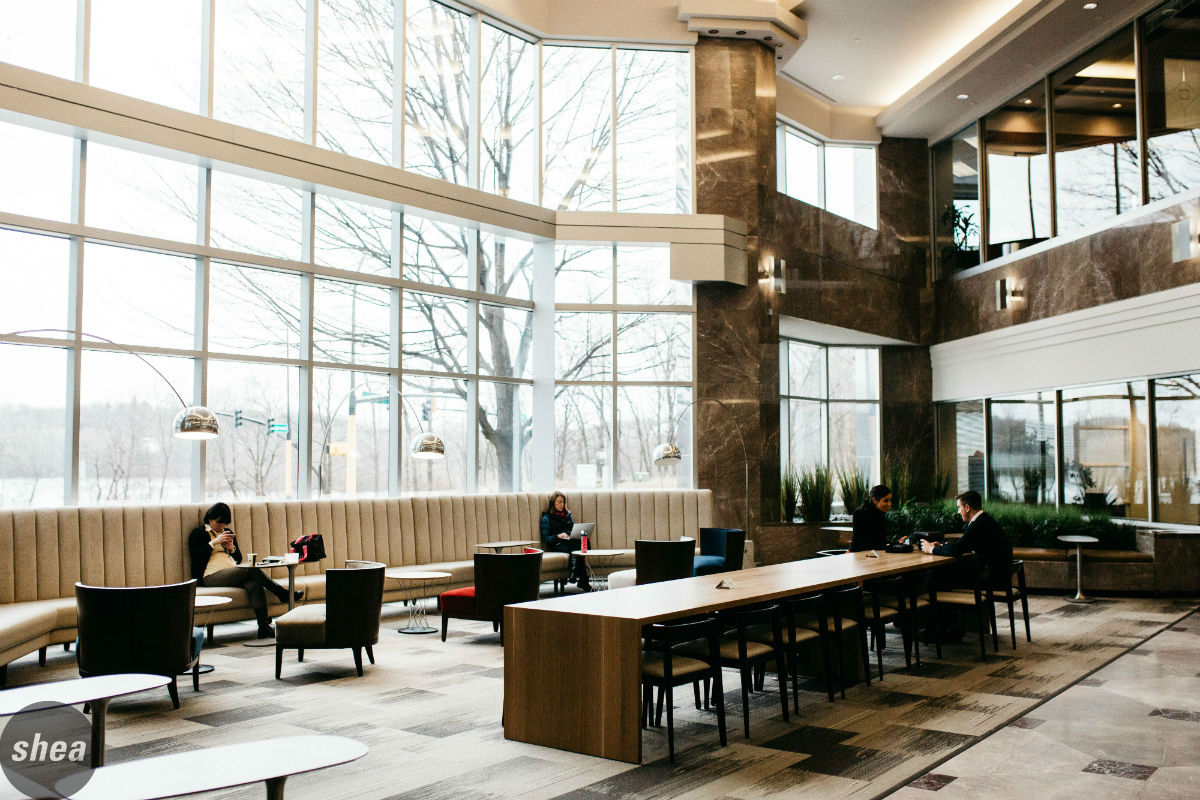
A similar emphasis on flexibility was placed on the design that the Shea team created at Normandale Lakes Office park. Formerly a basic office tower with few communal spaces for tenants to escape, the new design encourages workers to step away from their offices and work individually or collaboratively in spaces throughout the building. The main lobby, featuring a large window to show off the inspirational views, is filled with soft seating for quick meetings.
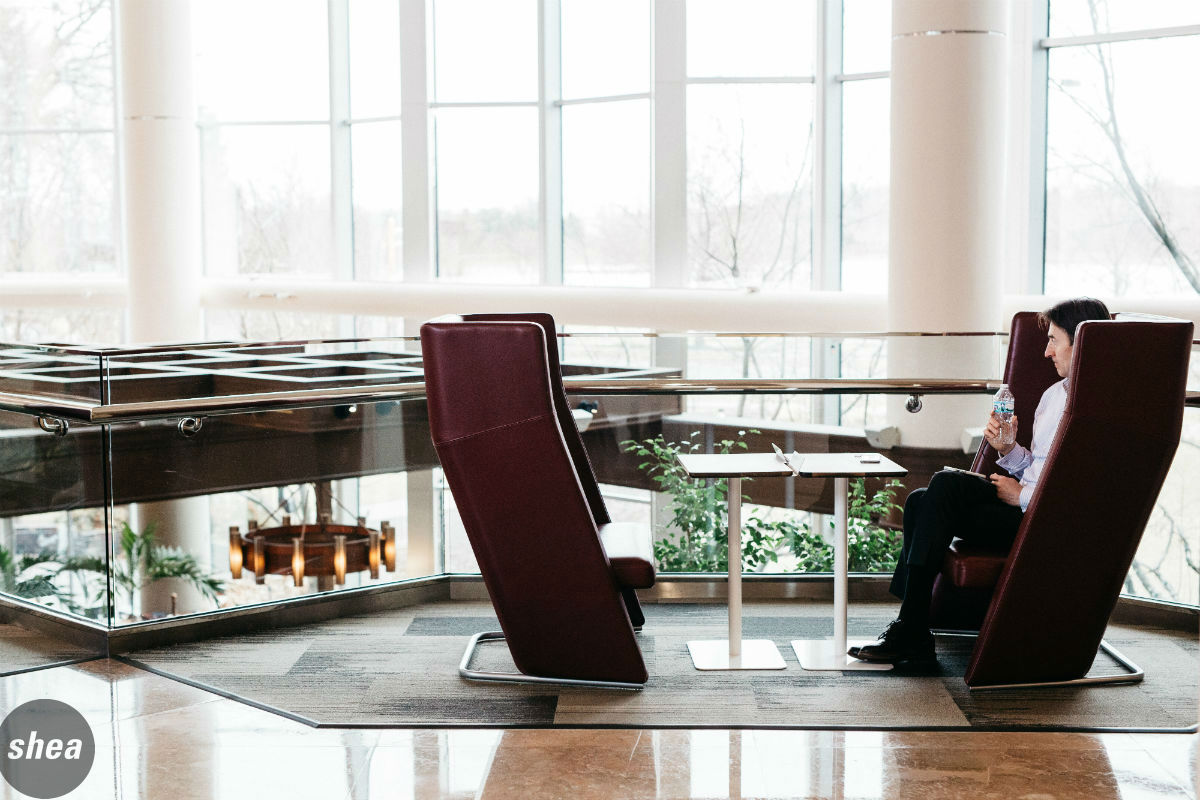 A quieter room beyond the elevator bank includes a banquette with small tables as well as a long library table with power ports, for tenants to settle in for longer-term individual work. And tables flanked by large leather chairs with curved edges on the skyway level add an element of privacy to stopping spots, perfect for tenants looking to make phone calls or get heads-down work done.
A quieter room beyond the elevator bank includes a banquette with small tables as well as a long library table with power ports, for tenants to settle in for longer-term individual work. And tables flanked by large leather chairs with curved edges on the skyway level add an element of privacy to stopping spots, perfect for tenants looking to make phone calls or get heads-down work done.
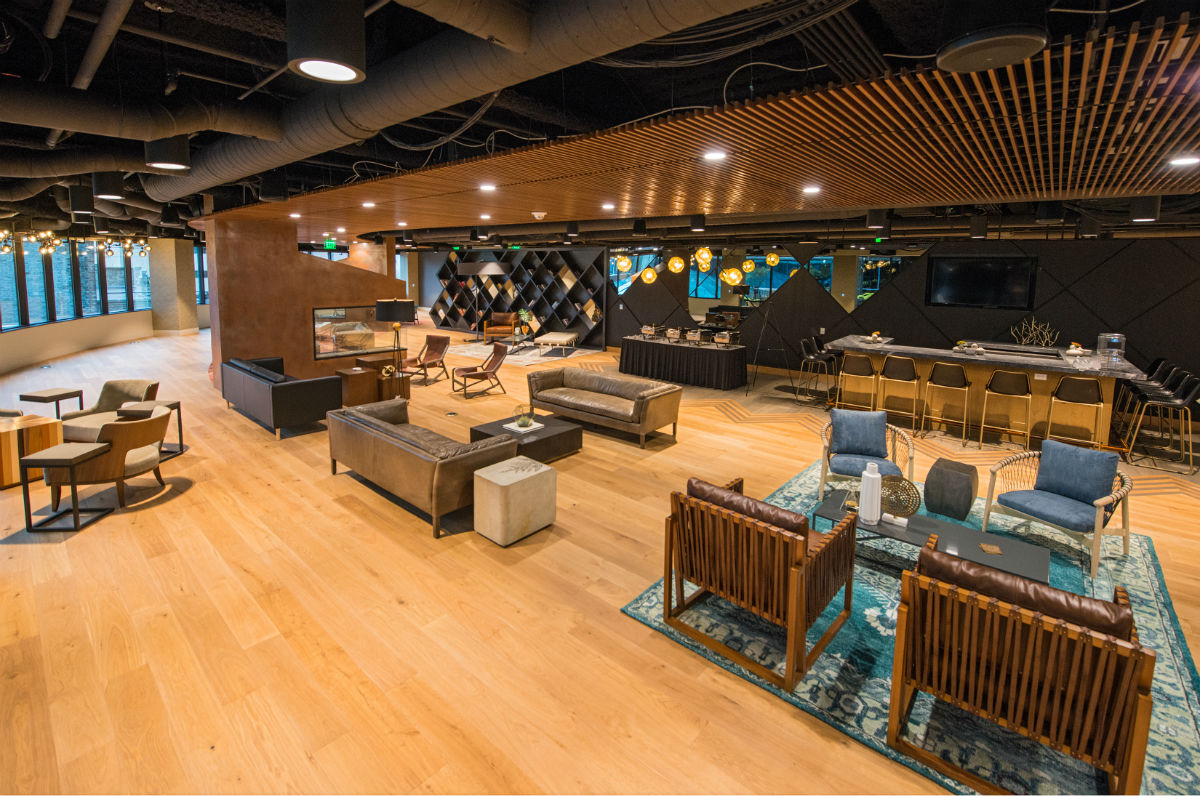
Connectivity and Engagement
Connectivity is another reason that coworking spaces are so functional—and it’s the reason that almost every multi-tenant office building needs to provide tenants a place to meet with other individual workers, bounce ideas off each other, and engage and innovate together. At the same time, socialization isn’t forced, but comes organically through the spaces in a coworking community. Providing just these kinds of spaces specifically designed for engagement, in both office buildings and company workplaces, has become a key tenet of Shea’s workspace-design philosophy.

In an office building, creating places to connect outside of individual offices is key. In the major revamp of Fifth Street Towers, a downtown Minneapolis office building in need of a refresh from its 1980s design, Shea created areas throughout the building that would allow tenants to use the entire office tower to their advantage, with no under-utilized spaces. There are seating spots scattered throughout the skyway that allow workers to pause to check e-mail, have an informal meeting, or take a breath in a busy day, as well as perches to stop for a beat and respond quickly to a call or text.
 There’s the first-of-its-kind Sphere Bar+ Restaurant, a circular bar in the center of the skyway that provides an easy lunchtime or happy-hour meeting spot for coworkers and connecting with other building tenants. And the third floor of the building was transformed into a haven for tenants, with conference rooms available to rent when they’re looking to hold an out-of-office meeting, outdoor space for work or leisure, and a sleek interior space that incorporates elements of work, play, and wellness for tenants.
There’s the first-of-its-kind Sphere Bar+ Restaurant, a circular bar in the center of the skyway that provides an easy lunchtime or happy-hour meeting spot for coworkers and connecting with other building tenants. And the third floor of the building was transformed into a haven for tenants, with conference rooms available to rent when they’re looking to hold an out-of-office meeting, outdoor space for work or leisure, and a sleek interior space that incorporates elements of work, play, and wellness for tenants.

But creating these kinds of spaces is also important in individual offices, as evidenced by the design at Little, a downtown Minneapolis design and branding agency. While each employee has their own desk space, the office is also packed with collaborative zones spread throughout, giving workers opportunities at every turn to come together. In the lobby, a banquette with tables for notetaking encourages brainstorming, and a communal table and three bar spaces in the oversize kitchen provide plenty of space to meet in small or large groups. A nook with writeable walls is a great spot for connecting and innovating, while large islands in the main workspace allow for impromptu meetings and easy places to spread out designs and campaigns.

As offices and the people who work in them continue to evolve, professional design needs to stay current with the way people work, while still employing practicality in design. Borrowing elements from coworking spaces is a great tool for design firms, because those are offices to which people not only choose to go, but pay a fee to do so. By incorporating factors such as engagement and flexibility into traditional office design, Shea is able to stay on the cutting edge, serving our best work to clients and companies.

